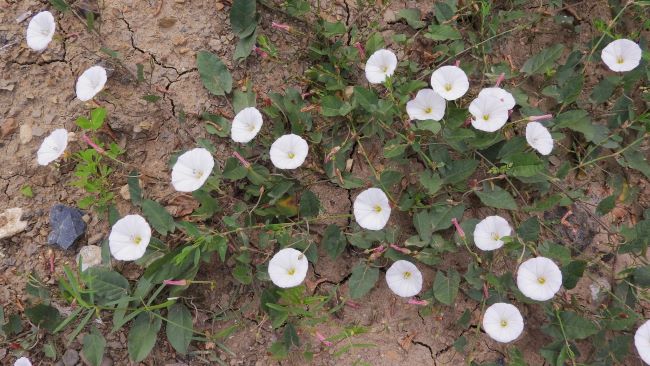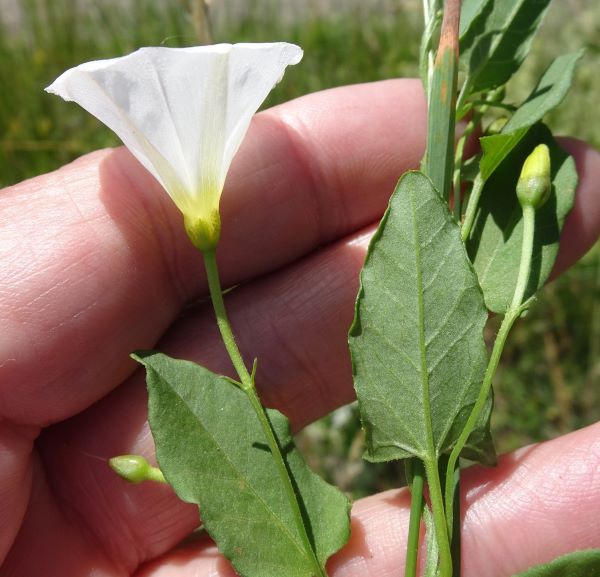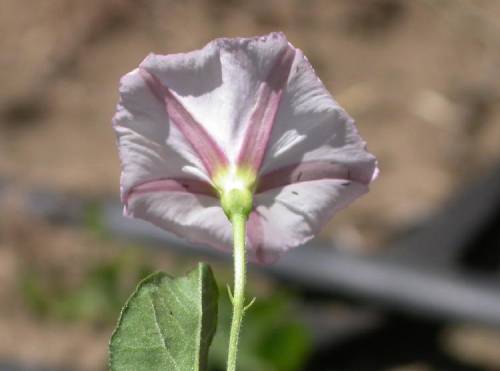Field bindweed identification and control
Information about the noxious weed field bindweed. Field bindweed is also known by its scientific name, Convolvulus arvensis.
About this weed
Field bindweed is a non-regulated Class C noxious weed. This means due to how widespread it is, property owners are not required to control this species on their property, though it is encouraged.
Field bindweed is in the morning glory family, Convolvulaceae. There are many types of bindweed, and they often are just called “bindweed” or “morning glory” but may actually be a different, but related species. Other common names for this particular species are lesser bindweed, European bindweed, perennial morning glory, small-flowered morning glory, creeping Jenny, and possession vine.

Why it's a problem
Field bindweed is very difficult to control organically and takes years of persistence to eradicate, though it may never be fully eliminated from the site. It outcompetes native plants and can reduce crop yields by up to 60 percent. Even when suppressed, the seeds can still germinate after 60 years.
Plant description
- Field bindweed is a perennial (plants that have a 2+ year life cycle), herbaceous (no woody stem) vine that grows along the ground and climbs aggressively.
- The leaves are alternate, meaning their leaves never grow nose-to-nose and instead take turns growing along vine.
- Leaves are arrowhead shaped and have smooth margins.
- Leaves and stems may appear slightly fuzzy.
- The flowers are trumpet or funnel-shaped, white to pinkish, and have 2 small bracts (small leaves or scales at the base of a flower) 1 inch below the flower.
- Field bindweed reproduces vegetatively from stem or root fragments and by seed.
- Seeds can remain viable in the soil for more than 50 years.
- It has deep-rooted rhizomes (horizontal roots that sprout new plants) and slender, twining stems that grow up to 6 ft long.







Be aware of look-alike plants
Field bindweed is often confused with other bindweeds, but most often:
Large and hybrid bindweed (Calystegia x lucana)
- Differences: has larger flowers and leaves, bracts are more obvious and overlap
Hedge bindweed (Calystegia sepium)
- Differences: has larger flowers and leaves, is hairless, arrow is more pronounced in leaf shape. Bracts are more obvious and do not overlap, somewhat obvious gap.

When in doubt, take photos and report them on iNaturalist.
What to do if you find it
Control of field bindweed is not required in King County, but we highly recommend it. Because of its impact, many public agencies are working to remove field bindweed from natural areas. We are not generally tracking infestations of field bindweed, but we can share location information with the public agency if you report it to us. We can provide advice on how to control field bindweed, but there is generally no legal requirement to do so.
Control methods
We recommend using a combination of methods to control noxious weeds. In areas with few weeds, it is important to act quickly before they become harder to control. Make a long-term plan as it often takes several years to get rid of most weeds. Start in the least infested areas first and then move into more heavily infested areas.
Successful control of bindweed requires consistent vigilance over several growing seasons. It is important to control new infestations when they are small, because spot control is the least expensive and the most effective strategy. Diligently remove new growth and encourage competition from desirable vegetation.
Consult your local master gardener group or try The Garden Hotline for tips and tricks on managing garden weeds.
Manual control
Repeated hand-pulling eventually works but is very labor-intensive. It is best to limit hand pulling and tilling to seedlings and do it in early spring when the ground is wet. Root fragments left behind may resprout.
Cultural control
Covering the bindweed with mulch, black plastic, or geotextile fabric is another option, but must be covered for 3-5 years. Bindweed can survive without light and sprout beyond the covering’s edge, so make sure to cover the whole patch and watch for regrowth along edges.
Field bindweed prefers full sunlight and moderate to dry conditions. Rotations of tall, shade-producing crops or perennial plantings can reduce impacts. Healthy stands of sod-forming grasses or dense bunch grasses and legumes can smother bindweed.
Chemical control
Stay safe when using herbicide:
- Always read the label before use.
- Wear a long-sleeved shirt, long pants, shoes, and eye protection.
- Follow state and local regulations.
Systemic herbicides (absorbed by foliage and moved throughout the plant to kill roots) can suppress bindweed. They are most effective when combined with other methods and monitoring.
Products containing glyphosate are effective when applied in the summer and fall before the leaves die. However, glyphosate is “non-selective” and will injure any foliage that it contacts, including grass. Selective broadleaf herbicides containing triclopyr or 2,4-D will not harm most grasses. Repeat treatment on regrowth as needed.
Here are tips to avoid damage to desirable plants:
- Paint or brush herbicide directly onto the bindweed leaves.
- Spray the bindweed foliage on the ground after carefully removing it from other plants.
See the PNW Pest Management Handbook for the most up to date and specific method for chemical control of field bindweed.
Disposal instructions
Dispose of all plant parts in a sealed bag in the garbage or landfill. Do not compost any plant parts as it can reproduce from fragments.
Noxious Weed Disposal - Washington State Noxious Weed Control Board

 Translate
Translate